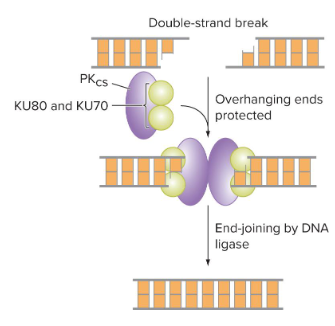Week 10 pt. 1
1/24
There's no tags or description
Looks like no tags are added yet.
Name | Mastery | Learn | Test | Matching | Spaced |
|---|
No study sessions yet.
25 Terms
Substitution Mutations + two types
Replacement of one base by another base.
Transition - same replaced with same.
Transversion - different replaced with different.
Purine bases
A and G
Pyrimidines
C and T
Deletion mutations
One or more base pairs are lost from the DNA.
Insertion mutations
One or more base pairs are added to the DNA.
Frameshift mutations
When deletions or insertions change the reading frame of a gene.
Causes changes downstream of mutation.
Can introduce early stop codons.
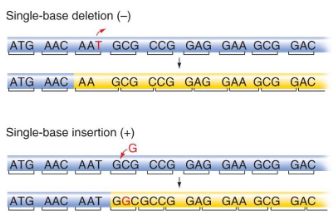
In each of the following cases, insertion mutations occur. The nucleotides that
are inserted are bolded. Assume each mutation occurs within an open reading
frame. Which of these insertion mutations is a frameshift mutation? Select all that apply.
a) ATACGTGTACATCGTAAC
b) ATACGTGTAATCGTAAC
c) ATACGTGTATCGTAAC
d) ATACGTGTACGCGATCGTAAC
b) and c)
Frameshift mutations only happen if the insertion or deletion is not in a group of three.
Inversion mutation
Segment of DNA is reversed.
Occurs when two double-stranded DNA breaks occur and the excised DNA is added back in the incorrect orientation.
Frequency of spontaneous mutations
Occur at a very low rate.
Most mutations do not affect phenotype. In genes, but still have no effect.
Are mutations heritable?
In multicellular organisms:
Only mutations in the germ cells will be passed along to future offspring.
Mutations in somatic cells are only passed to daughter cells in that individual.
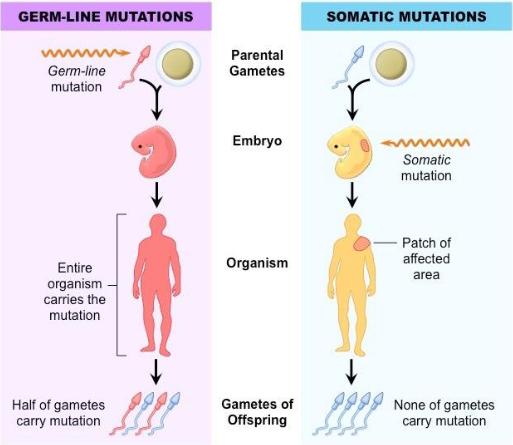
Why does oogenesis have more non-disjunction?
The long-term arrest of meiosis in egg cell precursors during prophase I increases the occurrence of non-disjunction during oogenesis compared to spermatogenesis.
What differences in sperm and egg production might account for sperm having more mutations than eggs?
Sperm gain more mutations because they’re made continuously through life, with each cell division adding mutation risk, while eggs are formed before birth and don’t keep dividing.
How do mutations occur? Randomly or in response to environmental stress? Experiment
E.coli culture grown for some time.
Plated equal portions of each culture with bacteriophage.
Any bacterial colonies must be resistant to virus.
The fluctuation test shows a high variation in the number of resistant colonies across cultures. This pattern matches random mutations occurring before exposure, not a uniform physiological response to the bactericide.
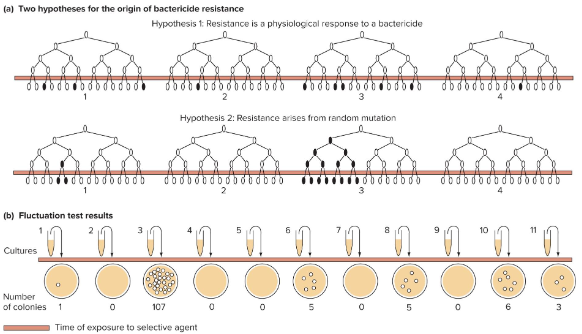
Replica plating experiment
Verifies that bacterial resistance is the result of preexisting mutations
Agar plate includes colonies of a type of bacteria killed by penicillin.
Create a stamp of cells, and transfer to agar plate containing penicillin.
Most cells die, cells with resistance form new colonies.
Position of resulting colonies tells you which colonies on the original plate had cells with resistance.
Conclusion of both experiments:
Resistance results from random spontaneous mutations that happen at various time points before exposure to the selective agent. Selective pressure is not causing the mutation.
Mutations occurring early in the growth of the liquid culture, resulted in many resistant colonies when plated; those occurring late resulted in few resistant colonies.

Two processes leading to mutations
Depurination - hydrolysis (removal) of purine bases
1000/hour in every cell. Random bases introduced during repair.
Deamination - removal of an amino group.
Can change C to U
After replication the normal C-G pair becomes A-T pair.
What type of mutation does depurination/deamination result in?
a) Deletion b) Insertion c) Substitution d) Frame shift
The correct answer is: c) Substitution.
Depurination or deamination alters a base, and when the DNA is replicated, the wrong base can be inserted, leading to a base substitution mutation.
Natural v Induced Mutations
Natural mutations - mistakes in DNA sequence occur at a low frequency all the time. Natural processes.
Mutagens induce mutations - any physical or chemical agent that raises the frequency of mutations above the spontaneous rate

Oxidative Damage
Oxidative damage can cause substitution mutations, often G→T transversions, because oxidized guanine (8-oxoguanine) can mispair with adenine during replication.
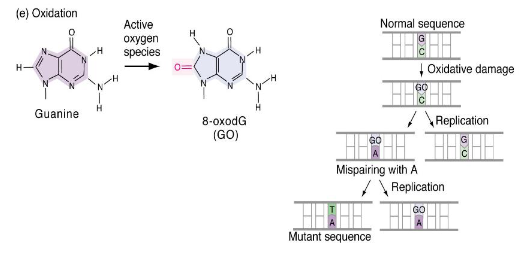
X-rays
Break DNA backbone. Results in deletion, translocation (Swapping positions, or inversion.
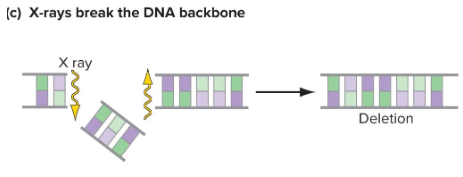
UV Light
Produces thymine dimers
Within-strand C-bonds formed. Introduces kink in double helix, prevents replication by DNA polymerase.
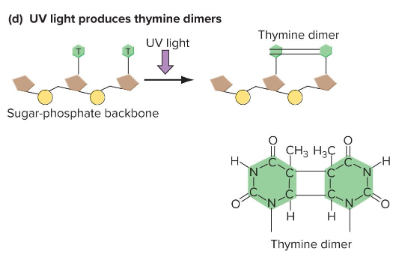
Proofreading
Proofreading portion of DNA polymerase - 3’ to 5’ exonuclease - fixes most mistakes made by polymerase.
Removes then adds correct base.
Error rate goes from 1 in 10-6 to 1 in 10-9 bases.
Base excision repair
DNA glycosylases remove altered nitrogenous bases and nearby nucleotides.
New DNA synthesized to fill in the gap.
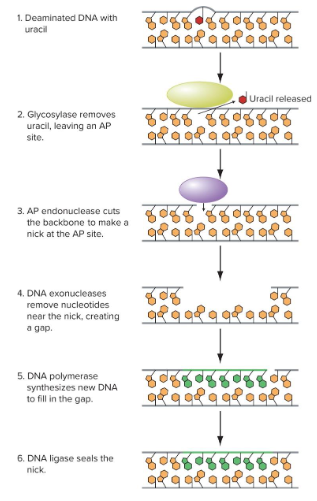
Nucleotide excision
UvrA and UvrB complexes scan for distortions in the double helix.
UvrB and UvrC complex cuts around the damaged DNA.
DNA polymerase fills in the gap.
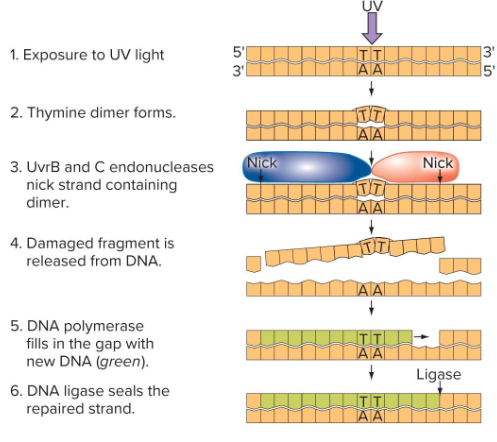
Repair of dsDNA breaks
Active during all parts of the cell cycle, not just DNA replication.
Two repair mechanisms:
- Homologous recombination - similar process to crossing over.
- Non-homologous end-joining (NHEJ), repair of double-stranded breaks without using a template.
